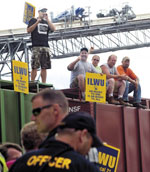
Showdown on West Coast Docks: The Battle of Longview
(November 2011).
click on photo for article

Chicago Plant Occupation Electrifies Labor
(December 2008).
click on photo for article
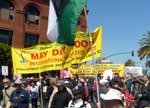
May Day Strike Against the War Shuts Down
U.S. West Coast Ports
(May 2008)
click on photo for article

March 2021
Now Is
the Hour – Organize the Unorganized with Workers
Power!
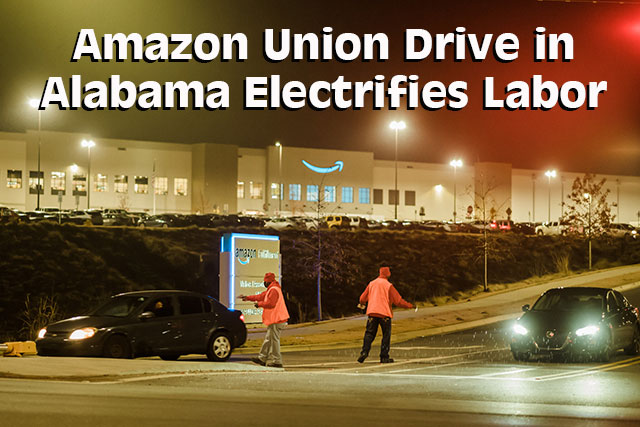 RWDSU organizers
leaflet outside Amazon warehouse in Bessemer,
Alabama. (Photo: Bob
Miller for the New York Times)
RWDSU organizers
leaflet outside Amazon warehouse in Bessemer,
Alabama. (Photo: Bob
Miller for the New York Times) On-the-Spot Report
BESSEMER/NEW YORK – On March 30, just one year after the opening of the massive BHM1 Amazon warehouse in Bessemer, Alabama, votes will begin to be tallied in an election by 5,805 workers on whether to be represented by the Retail, Wholesale and Department Store Union (RWDSU). The union organizing drive in Bessemer is being closely watched by the media, business, labor and politicians, from city councils right on up to the White House. It is an international event, pitting workers making $15 an hour against the second-largest company in the world. And it is of intense interest for Amazon workers everywhere, and those fighting for class-struggle workers action amid the deadly pandemic and coronavirus depression ravaging the capitalist world.
The stakes are high, first of all for the workers in the warehouse, whose shot at moving beyond poverty pay with no rights depends on the union winning. A victory for the RWDSU would be the first successful unionization election in the United States against the Amazon distribution and e-commerce monopoly, with over 800,000 employees in the U.S. and 1.3 million worldwide. It would be a victory against the viciously anti-union company headed by Jeff Bezos, off and on the world’s richest man, a robber baron in the tradition of Vanderbilt, Rockefeller and Gould. It would provide a beacon for desperately needed union organizing campaigns at Amazon, its Whole Foods subsidiary, Walmart, and for workers throughout the U.S. and beyond.
At BHM1, which opened just as the COVID-19 pandemic hit last March, the Bessemer warehouse workers are about 85% black and about 50% women. Bessemer is a poor, deindustrialized, majority black city. It also has a history of union organization. Within a very few months, the grinding conditions of Amazon employment led workers to approach the RWDSU, which has a regional office in Birmingham, 20 miles northeast of Bessemer. The RWDSU already represents thousands of workers at poultry and other food production plants in Alabama, Tennessee and Georgia, and thus had a network of organizers ready to assist the Amazon workers.
While Alabama is an anti-union “right-to-work” state as elsewhere in the South, it has a history of militant class struggle in campaigns that organized sharecroppers, textile workers, coal miners, and steel workers. Bessemer itself was founded as a steel company town, but by the late 1930s, the U.S. Steel plant was unionized by the leftist-led Mine, Mill and Smelter Workers. Organizing efforts in the South have always had to contend with the racist oppression of black people, the bosses’ biggest weapon when it comes to dividing workers and busting unions. Alabama markets itself to business investors as an anti-labor, low-wage state, but it still has the highest percentage of unionized workers of all the states of the former Confederacy.
Amazon Relentlessly Monitors Time Off Task

Amazon's Staten Island warehouse JFK8 in 2019. The company treats robots better than human workers, relentlessly monitoring "time off task." (Photo: Hiroko Masuike / New York Times)
In February, The Internationalist sent reporters to Alabama to cover and support the unionization campaign. Workers hired in Bessemer told us that they soon realized that in the hyper-automated Amazon warehouses, where the robots are treated better than the human workers, they needed a voice. Workers complain that they have to walk more than five minutes from their workstations to get to a bathroom, and if they have to wait to use it, they can end up facing discipline for exceeding the maximum amount of “time off task” (TOT) allowed per day. TOT means time of “inactivity” when scans are not being recorded (Amazon uses technology to constantly monitor worker activity, in order enforce a breakneck production pace).
On the eve of World War I, Henry Ford launched the production line to mass produce automobiles, with workers doing repetitive action to achieve maximum efficiency in a non-stop flow. (Ford was later a sympathizer of Nazi Germany, received an award created by Hitler and used slave labor in his German factories.) Amazon warehouses today are Fordism on steroids.
Workers report that if they have any problems, the company is unresponsive and unaccountable. Managers refer workers to Human Resources, and HR tells them to go back to their supervisor. Instead of sick days, if you miss a day of work you’re considered “on leave,” and leaves are handled by an outsourced company which communicates poorly with the onsite management. When Amazon notifies a worker that they have possibly been exposed to a coworker who tested positive for COVID, they send the worker home and tell them to get tested, but they won’t pay them for workdays missed while waiting to get test results.
There are a multitude of issues that could result in discipline or firing, from not meeting the production “metrics,” to “poor time management” to dress code violations, and these are used as a pretext for getting rid of union activists. Without a union contract and representation, the workers are at the mercy of the bosses. One worker summed up why she came to support the union: “Amazon is so automated that I think it’s a detriment to human beings. So I started to realize quickly after a month or two months that this union thing was probably the way to go, regardless of how I felt about it before.”
RWDSU organizers told us that after workers approached them and told them of the conditions and sentiments in the warehouse, the union realized that the facility was a “hot shop” that could be organized rather sooner than later. A major factor was the massive upsurge of anger and protest that erupted across the country after the racist murders or Ahmaud Arbery, George Floyd and others. During the long hot summer of protest last year, many workers hired in the plant saw the need to stand up for themselves as workers, just as protesters stood up against racist cop terror. Young anti-racist activists, both black and white, were part of newly hired workforce of the warehouse.
The Organizing Drive Takes Off
 NYC demo in solidarity with
Bessemer union organizing drive, March 4. (Photo: View Press / Getty
Images)
NYC demo in solidarity with
Bessemer union organizing drive, March 4. (Photo: View Press / Getty
Images)After a period of securing a base of supporters in the warehouse, on October 20 the RWDSU launched an intensive campaign to obtain some 2,000 authorization cards to qualify for a vote according to the rules of the National Labor Relations Board (NLRB), an agency of the capitalist government whose function is to manage and suppress class struggle. The RWDSU set up a union tent next to a gas station near the facility, put up signs and banners along the roadways, and stationed organizers at every entrance to the warehouse property for every shift, starting at 4:30 a.m. and going around the clock, where they handed out literature and authorization cards.
The Amazon bosses were taken by surprise, but soon realized the union campaign had traction, and in turn they launched an intense daily anti-union propaganda barrage at the workers. Spending millions of dollars, Amazon hired at least ten anti-union consultants, paid $3,200 a day each plus expenses, to hold “captive audience” sessions with the workers, spreading lies and misinformation against the RWDSU and unions in general. These meetings “pissed off” the workers, but continued until the union representation voting began on February 8.
Anti-union messages were spread via teleprompters in the warehouse, daily text messages to employees’ phones, even stickers in the bathroom stalls. Speaking of management’s anti-union campaign, a worker told us, “Everyone there wants you to drink the Amazon Kool-Aid.” The company set up a slick lying anti-union website, “#DoItWithOutDues.” It forced contract cleaners in the warehouse, many of them former prison inmates desperate for work, to wear “Vote No” pins. It handed out T-shirts and anti-RWDSU rearview mirror hang tags. And Amazon hires off-duty Bessemer police, who sit in marked police cars with lights always flashing, to keep union activists – and reporters – off the property.
Amazon brought in supervisors from its facilities around the country to hound the workers as they work. As one worker told us:
“There is a whole gang of them for each shift. They will come to your station and say we’re here to talk to you about the union, do you have any questions? When you are already confused and scared, this person comes up to you and starts spewing. They sent them all down here to talk to us when you’re working. They are incredibly shrill and annoying. I have never seen any of them do any task that did not involve yammering in somebody’s ear.”
To account for the fact that harassing workers while they work can’t help production (and is a safety hazard), Amazon relaxed its production quotas for workers subjected to these verbal assaults. The bosses are hellbent on stopping the union in Bessemer, so as not to have an example set for other workers.
To obstruct the union organizers, Amazon even induced Jefferson County authorities to alter the traffic lights at the main entrance to the warehouse, so that for any car leaving the property, the light changes to green in about three seconds. This was done to prevent organizers from having time to talk to workers waiting at the light. At this intersection, alongside the RWDSU, we distributed a leaflet with our article “Bust Bezos, the Modern-Day Robber Baron—Unionize Amazon and Whole Foods!” (The Internationalist No. 55, Winter 2019) to several shifts.
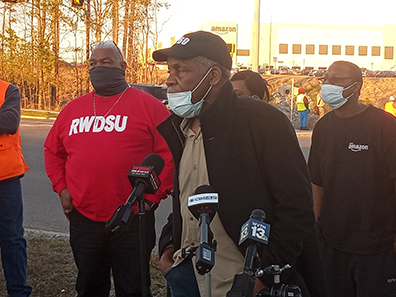 Danny
Glover at press conference in support of Amazon workers
unionizing drive in Bessemer, February 22. (Internationalist photo)
Danny
Glover at press conference in support of Amazon workers
unionizing drive in Bessemer, February 22. (Internationalist photo)In a swift campaign of just about five weeks, the RWDSU, assisted by the activists in the warehouse, achieved success such that the union filed for an election with the NLRB on November 20. Not knowing exactly how many workers worked in the plant, the union initially presented 700 cards and said it would represent 1,500 workers. Amazon told the NLRB that the union was way short, in fact there were 5,800 workers there. The union then replied, “give us 45 minutes,” and scanned and sent all the cards that were needed. The election was now authorized, and the campaign which had flown under the media radar was now announced to the public.
Due to the COVID pandemic, the NLRB ruled that the election was to be done by mail. Amazon wanted in-person voting, the better to intimidate workers – it even offered to buy a hotel to provide a venue for in-person voting. The NLRB rejected this proposal. Amazon subsequently had the U.S. Postal Service install a mailbox at the entrance to the warehouse, texting workers and sending them mailers telling them to vote “no” and drop the ballot in that mailbox.
Class-Struggle Unionism vs. Appeals to Democrats
On February 6, on the eve of the mail-in ballot period, the RWDSU held a rally in cold rain in a field near the warehouse. This was a demonstration of labor solidarity, with representatives of the Teamsters, the International Brotherhood of Electrical Workers and the Communication Workers of America, some coming from Atlanta and New Orleans. Labor solidarity is the key to organizing success. The industrial unions were built by “reds” in the 1930s and ’40s – like the Communist-led Mine-Mill union at U.S. Steel – through hard, often bloody class struggle against the capitalist governments, its police and security guards (see back page, “Fight Against Racist Terror, Key to Organizing the South”).
On February 28, President Biden posted a video on the POTUS Twitter page expressing solidarity with the union organizing drive at Amazon (without directly naming the company). Union leaders had been urging this for weeks, and now they are highlighting it. This recalls how in 1935, after Franklin D. Roosevelt pushed through the Wagner Act, Mine Workers leader John L. Lewis declared, “The President Wants You to Join a Union.” But while FDR’s law legalized unions, it subjected them to elaborate government control through the NLRB. Democrats may issue statements in support of workers seeking to unionize, but when it comes time for a hard strike – which is what it will take to win anything from Amazon – these phony “friends of labor” have always demanded that the union bureaucrats toe the line and suppress workers’ militancy.
Stuart Appelbaum, the president of the national RWDSU, also sits on the executive committee of the Democratic National Committee, the leadership body of that party of imperialist war, racist repression and capitalist exploitation. This underlines how the labor bureaucracy chains the unions to the bosses’ parties. But the road to successfully organizing Amazon and other union-busting exploiters will not be a policy of abiding by the bosses’ rigged labor laws. An article in Bloomberg Businessweek (10 March) noted:
“Amazon has fought hard to keep unions out of its U.S. operations and will have a menu of options if the vote doesn’t go its way, such as contesting the result, dragging out talks with the union, or closing the 855,000-square-foot warehouse entirely, a prospect already on the minds of some Bessemer workers and politicians.”
Note that at Amazon’s DCH1 warehouse in Chicago, one of the first sites of pro-union agitation last year by Amazonians United, the company announced in December it was closing the unit, and gave workers the “option” of working ten-hour “megacycle” shifts that begin after midnight and go to around noon, or find a new job, effectively excluding workers with children to care for.
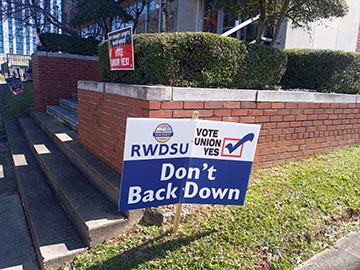 Sign outside RWDSU
headquarters in Birmingham. Amazon workers are facing a
massive intimidation campaign by the company. Vote
union!
Sign outside RWDSU
headquarters in Birmingham. Amazon workers are facing a
massive intimidation campaign by the company. Vote
union! (Internationalist photo)
One way that union leaders express their submission to capitalist laws is how they answered Amazon’s union-busting “do it without dues” appeal, by hiding behind Alabama’s anti-labor “right-to-work” law! The RWDSU’s BAmazon Union Newspaper (February 2021) had a front-page box declaring “Fiction: You will have to pay union dues. Fact: The State of Alabama never requires you to pay union dues in a union shop.” This attempt to conciliate company-instigated backward consciousness will ultimately boomerang against the union.
The RWDSU reports that as news of the Bessemer union drive has spread, more than 1,000 Amazon workers from around the country have already contacted the union, seeking information about unionizing their workplace. And in Italy on March 22, 8,500 unionized Amazon workers carried out a national one-day strike against Amazon demanding reduced workloads and working hours. In Europe, unions have carried out strikes and won representation of many Amazon workers. But even there, the giant company has run roughshod over union complaints about the lack of COVID protection in its facilities.
In Iowa, where the Teamsters are organizing drivers and warehouse workers, a union leader told the Des Moines Register (26 February): “Amazon has proven, time and again, that they have no respect for the workers’ right to organize under the (National Labor Relations Board) and the election process.” Instead, the Teamsters would rely on strikes to demand higher pay and less stringent rules, “particularly regarding how fast warehouse employees and drivers have to work.” The organizing drives that built the Teamsters into a powerhouse of labor were waged with class-struggle methods pioneered by the Trotskyist organizers of the Minneapolis Teamster strike of 1934, independent of and against the capitalist government and politicians.
Democrats, No Friends of Workers – For a Class-Struggle Workers Party
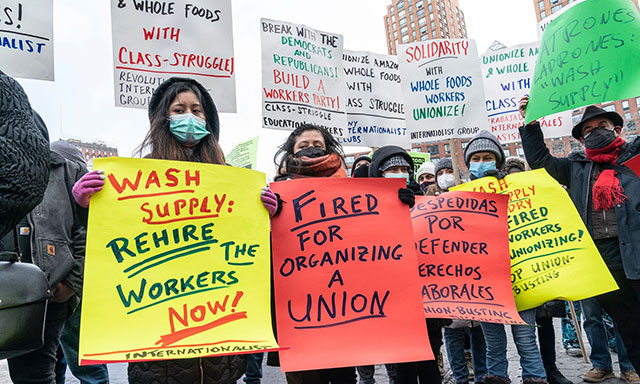
On February 20, the day after immigrant women workers from Wash Supply Laundromat in New York City were fired for forming a union, they attended a demonstration of solidarity with Amazon workers in Alabama.
(Photo: Lev Radin / Pacific Press)
In the past year, while most of the U.S. economy cratered, Amazon’s revenue was up 38% (to $386 billion), its profits soared by 50% (to $20 billion), the company went on a hiring spree, increasing its number of employees by more than 60% (going from 800,000 to 1.3 million worldwide in one year) and Jeff Bezos’ net worth grew by $75 billion (to $188 billion). As millions of people stuck at home because of the coronavirus pandemic relied increasingly on delivery services, Bezos and Amazon are riding high, raking in the dough. Amazon workers, not so much: aside from a couple months of $2/hour hazard pay in the spring, employee wages have not gone up at all. Yet these are front-line, essential workers who have been hard-hit by the deadly plague. Not that Amazon cares.
On October 1, Amazon reported that 20,000 of its employees had fallen ill with COVID-19. This may seem like a staggering figure, but it almost certainly is far short of the actual numbers. After complaints about inadequate sanitary procedures and failure to notify employees of cases, the attorneys general of New York and California requested detailed reports on cases from Amazon. The company has yet to turn over the information. In any case, reports from workers call Amazon’s figure into question. In an open letter last July, Inland Empire Amazonians United at ONT9 in Redlands, California said they had received “at least 23 different notifications on our AtoZ page regarding positive cases in the warehouse,” while workers at a large East Coast facility continue to receive AtoZ notifications of new COVID cases several times a week.
Faced with Amazon’s stonewalling, the California and New York attorneys general have sued it over failure to comply with subpoenas and to maintain safe workplaces. The New York brief notes that “Amazon received written notification of at least 250 employees at the JFK8 facility who had positive COVID-19 tests or diagnoses,” that in more than 80 of those cases the company failed to close any portion of the warehouse even after being notified, and even closures of workstations of diagnosed workers were perfunctory, often for only 90 minutes. Yet even should these suits succeed, the result would be no more than a slap on the hand for the giant company. In California, Amazon was fined only $935 each for two facilities (Hawthorne and Eastvale) where workers complained of unsafe conditions after a manager died at Hawthorne.
On top of its willful neglect of COVID safety, Amazon is notorious for its high injury rate: 14,000 serious injuries in 2019, or 7.7 per 100 workers, almost double the warehouse/storage industry rate nationally and increasing every year. The Internationalist Group has called for unionization at Amazon for several years, and in particular for the formation of worker safety committees empowered to close dangerous workplaces. Last May 1, we joined with workers protesting at DLA8 in Hawthorne, with signs calling to “Unionize Amazon with Class Struggle” and “For Workers Health and Safety Committees.” And at JFK8 in Staten Island, New York, IG signs declared, “Amazon Workers: Shut It Down, Clean It Up, Unionize!” and “Trump & Democrats, Enemies of Workers – For a Class-Struggle Workers Party.”
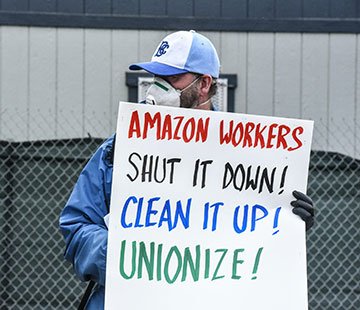 Internationalist Group
sign at 1 May 2020 protest at Amazon Staten Island
warehouse, at the height of the coronavirus pandemic in
NYC. Amazon still hasn’t turned over detailed information
on the numbeer of employees infected with COVID-19.
Internationalist Group
sign at 1 May 2020 protest at Amazon Staten Island
warehouse, at the height of the coronavirus pandemic in
NYC. Amazon still hasn’t turned over detailed information
on the numbeer of employees infected with COVID-19.
(Photo: Stephanie Keith / Getty Images)
This is in sharp contrast to the Democratic Socialists of America (DSA), “socialists” firmly entrenched in the Democratic Party. The Birmingham, Alabama, DSA has put up banners and promoted the union cause in Bessemer, while pushing for Biden to support the organizing drive. Now the DSA is calling on Biden to “use his bully pulpit” to support the Democrats’ “Protecting the Right to Organize” (PRO) Act, which just passed the House of Representatives. Marxists support any measure lifting restrictions on the right to organize, but the DSA program of pressuring the capitalist Democrats is counterposed to the class struggle that will be needed to build a fighting labor movement. Similarly, the reformist Workers World Party (WWP) has initiated national protests in support of the Bessemer union campaign, on February 20 and March 20, while lauding the union bureaucrats’ appeal to Biden and other Democrats for support.*
As we wrote in our article two years ago: “What’s needed is to break the chains that bind wage slaves to the modern slave masters, to build a workers party to fight for a workers government! Solidarity – one section of workers defending another and recognizing that our interests are the same – isn’t just a nice idea: it’s the only possible way in which workers at Amazon, or anywhere else, can fight back effectively and win. Organize Amazon and Whole Foods workers!” ■
* Correction: (From The
Internationalist No. 63) It has been brought to our
attention that the reference in our last issue to
demonstrations of support to the union organizing drive at
Amazon in Bessemer, Alabama being initiated by the Workers
World Party was inaccurate. The solidarity demos on
February 20 were in response to a call by the Southern
Workers Assembly.
Fight Against Racist Terror
Key to Organizing the South
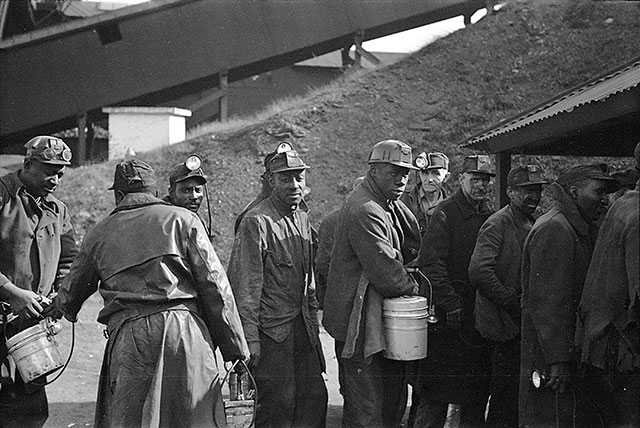
Black and white miners in Birmingham in 1937 when the Mine, Mill and Smelter Workers established itself. An integrated union in the Jim Crow South, Mine Mill was always under attack by bosses seeking to stoke racism. (Photo: Arthur Rothstein / Library of Congress)
Bessemer’s history of labor organizing goes back a century to the International Union of Mine, Mill and Smelter Workers, formerly the syndicalist-led Western Federation of Miners. A retrospective on Mine Mill in Alabama on National Public Radio (5 December 2018) starts with how in 1918 the miners working Red Mountain (so called because of the iron ore found there) south of Birmingham called in the radical union to unionize the former Tennessee Coal and Iron plant which had been taken over by United States Steel. When a pair of Mine Mill organizers showed up that year – one black, one white – the company formed a vigilante group which kidnapped and beat them up, tarring and feathering and threatening to lynch the black unionist. That U.S. Steel-organized goon squad became the Jefferson County Ku Klux Klan.
By the 1930s, Mine Mill was back. 80% of the miners were black, and Mine Mill had both black and white workers and union officials. In rigidly segregated Jim Crow Alabama, this was a real threat to the racist social order, and the union was viciously red-baited. The union had to meet in the woods, and during strikes in 1934 and 1936, Red Mountain became a battlefield. Eventually Mine Mill was recognized as the official union and won higher pay and better working conditions. U.S. Steel struck back by seeking to supplant black workers with white workers, and by the late 1940s the union was more than half white. This was in the middle of the post-World War II “red purge” in the unions. The 1947 Taft-Hartley Act prohibited Communists from being union officials, and CP-led Mine Mill – the union featured in the classic 1954 film Salt of the Earth1 – was kicked out of the Congress of Industrial Organizations (CIO).
Then in 1949 the United Steelworkers (USWA), led by anti-Communist bureaucrats tied to the Democratic Party, challenged Mine Mill in Birmingham-Bessemer in an NLRB-ordered union recognition election. “The night before the vote, about 100 Klansmen rode by the Mine Mill office, waving torches, sounding horns,” NPR recounted. The next day the USWA won the vote. So here you had Democrat-led red-baiting labor bureaucrats, using anti-communist laws and a government agency to witch-hunt a left-led union, and allying with the KKK, which got its start in Birmingham as company-organized vigilantes. And today, Amazon once again is using labor spies from the Pinkerton agency, which got its start in union-busting in the steel industry.
Conclusion: A class-struggle fight to organize labor, breaking from the class collaboration of the pro-Democratic Party bureaucracy, is inseparable from the fight against racist terror.
But Mine Mill didn’t go away. Horace Huntley, a black historian whose father and grandfather were in Mine Mill, reported how in writing his PhD thesis – the basis for his book Black Workers’ Struggle for Equality in Birmingham (University of Illinois Press, 2007) – he interviewed older miners. One of them told him, “If not for Mine Mill, Martin Luther King could not have come to Birmingham.” In fact, the integrated union laid the foundation for the civil rights movement, Huntley said. The stepfather of Fred Shuttlesworth, who led the 1963 Birmingham campaign, was Mine Mill, and “the mining district, the Mine Mill area, for decades before the civil rights movement, it had already been abuzz with ideas about social justice.” ■
- 1. The film, about of the 1951 union organizing strike of Latino zinc miners in New Mexico, was directed by Herbert Biberman with screenplay by Michael Wilson, both blacklisted by Hollywood as communists. See “Learning from Salt of the Earth,” Revolution No. 13 (November 2016).